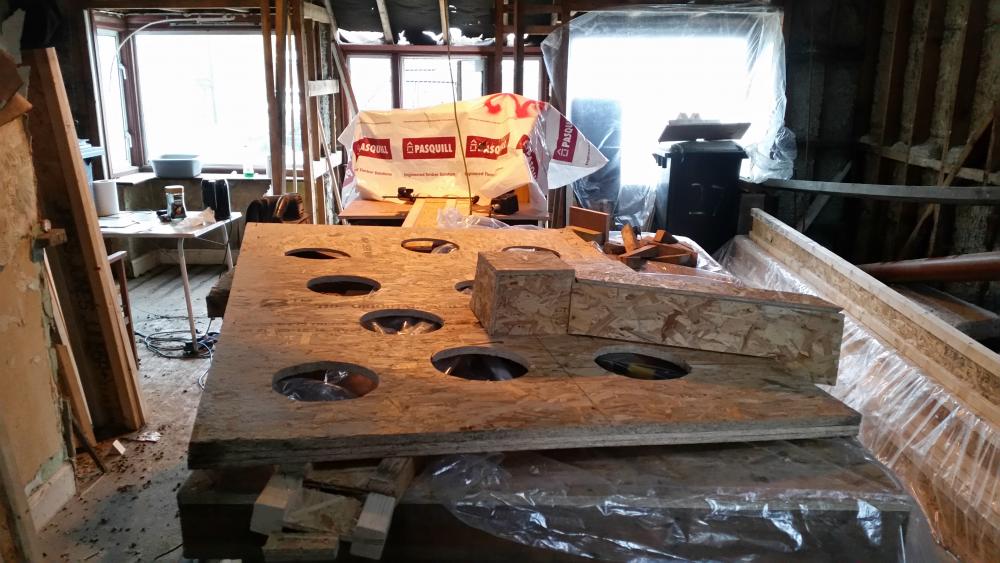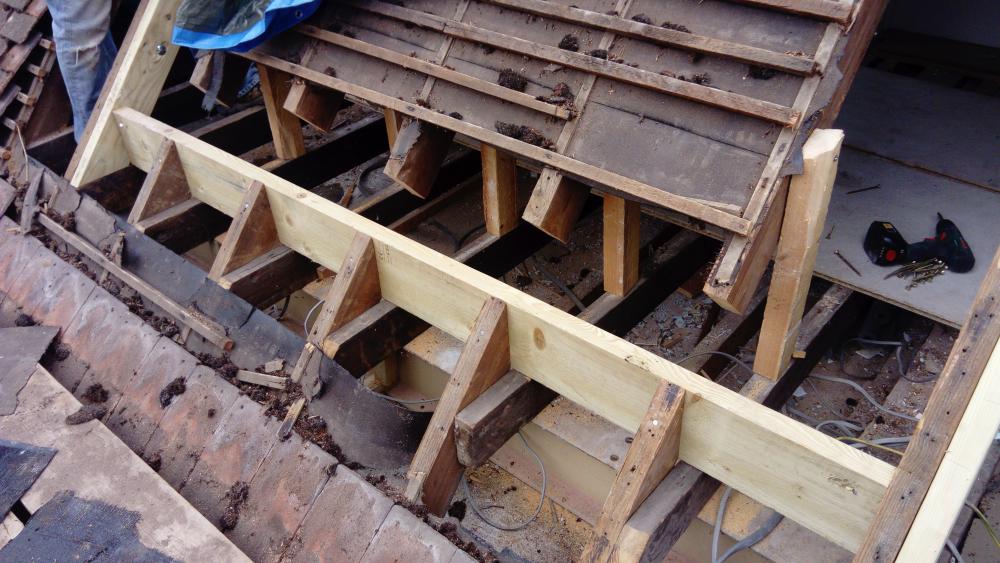Leaderboard
Popular Content
Showing content with the highest reputation on 03/12/17 in all areas
-
Here is the former I have made for our wet rooms 1200 x 1200 tray and 600 more of flat tiling (upside down here). Holes all have screw down plugs that will allow me to check the concrete in the slab is everywhere I want it and they will then be closed. The boxes are for the trap and the outfall pipe that runs to the main foul riser. All I have to do is ensure it doesn't float when we pour the concrete on Thursday. No UFH under the first one but there will be in the second one in the second slab where hopefully this former will get a second life - what ever happened to second life?2 points
-
@Dee, i have to say that there should be 1:5 sectional detail drawings from the architect. this should all be drawn for you. by headers, do you mean the timber across the width of the opening? if so i'd go with a double 6 x 2, joist spacing at 6 x 2 at 600mm centres especially if the opening is 2.4m. joist sizing as a rule of thumb, 6x2 =12+1 gives a span of 13', rafters 6x2=12-1 gives a span of 11', this works for all sectional sizes. this doesn't work for trimmers/trimming joists simon2 points
-
Do it don't tell anybody. We have 3 lakes and a number of large ponds, every time we look into getting consent for something it ends up costing us a fortune. Tell nobody don't upset anybody doing it and get it done. The one in the pic is about a third of an acre, took a week with a 14 ton machine. No spoil left the site cost £1400 to dig and about £200 to plant it and re,seed around it with a wildflower mix. But then again don't listen to a word i say I'm just a bit dodgy. ?2 points
-
It depends on whether you're required to comply with SuDS or not ( http://www.susdrain.org/ ). If you are (and we were, it's not in our planning permission but is in the planning policy that applies to all new developments) then you need to ensure that water cannot run off from any hard landscaping (drives, paths etc) and leave your boundaries. If you have a non-permeable subsoil, like clay, then you can either: - Make the area under the paving permeable, by digging out to a fair depth, fitting drainage crates for surge storage, arrange for that collected water to drain away somehow and use permeable base to lay permeable pavers over this, or, - Fit drains around the edges/bottom of the hard surface to collect any run off and either feed it to a suitable drain or collect it in some form of surge storage system that can slowly drain somewhere. We installed twenty heavy duty Aquacell crates, wrapped in terram, just above the water table and about a metre under our drive. These drain into a thin layer of soil above the clay that has a pretty slow drainage rate (long percolation time), but this is OK as the surge storage capacity we have is about 3,920 litres, so we can take the maximum storm rainfall OK without water running off into the lane. The alternative is to use a combined sewer, that will take surface water as well as foul drainage, but I'm pretty sure that most water companies are now either restricting this, or refusing to allow it altogether, because of the capacity problems it creates for them. Whether you opt to use permeable pavers or non-permeable with edge drainage really comes down to the topography. We have a drive that slopes down to the lane at the entrance, and a linear interceptor drain across the entrance wouldn't have been able to take the flow under the max rainfall from the table in building regs, so we pretty much had to use permeable pavers with drainage underneath. Permeable pavers aren't the only solution to complying with SuDS, though, and there are some other options on the Susdrain website.1 point
-
1 point
-
I doubt you need to go down more than about 300mm to eliminate the risk of pipes freezing, based on some measurements I did for fun some years ago. I built a weather station, with a wireless link to the house, and had a couple of spare temperature sensor inputs. As the thing was sat on a post hammered into the ground, I decide to fit a sensor about 300mm into soil, just to see how cold it got. This was a few years ago, and the soil at that depth never dropped below about 6 deg C, even when we'd had a spell of very cold weather (well below zero) for a few days. My guess would be that perhaps the top 100mm or so of soil might possibly freeze in prolonged cold weather.1 point
-
Select the right timber ( roof / floor etc ) at the top of each chart and fill your boots. Link1 point
-
Block will be pretty good at keeping out airborne noise, but not so good at ground-transmitted low frequency "noise", so it really depends on how much of the railway noise is airborne and how much is vibration transmitted through the ground. Reducing sound from vibrations transmitted through the ground really needs flexible isolation, with the isolated structure having enough mass to ensure that it has a resonant frequency that's a lot lower than the lowest transmitted frequency, which may not be that easy to build. A surprising level of sound comes in through tiny air gaps, too, I've found. I can say that blown cellulose insulation between two, fairly well isolated, stud walls seems to be incredibly good at reducing external sound penetration, something that I wasn't expecting. Our new house is, if anything, too well sound insulated, as you can't hear anything going on outside, not even a Chinook flying overhead, when the doors and windows are closed and latched. Whenever I have heard a sound inside it's always been because a door has been closed, but not latched tight to its seals. It means that even a truck coming up the drive can't be heard inside, let alone a car. If you go for a stud wall, then I'd be inclined to fill it with dense insulation and try to isolate the skins on either side. If you go for block, then it will probably give better airborne noise reduction, but may be a bit worse at reducing structurally transmitted sound. An example of this is the way sound like a light switch click may well be clearly audible from the other side of a block wall - something that's noticeable in our old house, that has block inner walls, but isn't noticeable in the new house that has acoustically insulated standard stud walls.1 point
-
You can do this, and our ASHP has a DHW setting, via dry contacts or the programmer, so that it can receive a call for DHW and increase the flow temperature to 55 deg C. In practice you're better off using an immersion heater during the cooler, damper, months, though, as the ASHP runs around three or four defrost cycles per hour in cool, damp, weather and the real-world COP (not the highly optimistic dry air COP often quoted) drops to close to unity. I ran a lot of experiments with our ASHP, to try and understand how it worked. Ours has an outside air temperature sensor and a humidity sensor and uses these to determine when there is an icing risk and when to run a defrost cycle. When defrosting it goes into cooling mode, drawing heat from the house or hot water system to warm up the heat exchanger and melt any ice. A typical defrost cycle takes around 10 minutes, so any more than three defrost cycles per hour takes you into the region where the real world COP is at unity or below. The main factor seems to be humidity, rather than just air temperature, so the worst performance isn't in cold weather, it's in cool, wet, weather. Sadly, we seem to get a fair number of days in autumn, winter and spring where the humidity is high enough to cause a problem. The solution was to not use the DHW capability of the ASHP and set it to a maximum flow temperature of 40 deg C. At this flow temperature it never seems to need to defrost when meeting our pretty low heat demand, so always gives a pretty good COP, better than the published data would suggest most of the time, I think. The best solution for heating an DHW from an ASHP seems to be to use a hybrid, like the Daikin Altherma. They use the ASHP part for pre-heating DHW and running the heating system, with a gas combi to boost the DHW. The big advantage is that one of these uses much less gas than a conventional combi system, because most of the "heavy lifting" is down by the heat pump taking the water to within about 15 deg C of the required DHW temperature, so it is a reasonable option for running from LPG.1 point
-
On topic: One probem imo is that paybacks can be relatively long term. I think that @AliG has something in saying that Double Glazing and Central Heating have now become essentials for most people. Around here it is very significantly more difficult to let out such properties unless you are well-down the market. I can see decent EPC numbers and other items developing that way. It just takes a generation to bed in. Our rate of newbuild of 1/3 of eg Germany doesn't help either. I think the energy explanations have political factors too, which obscure the common sense rationality. Energy is relatively cheap. Energy is required to be portrayed as expensive because people need to prove that a market-based-as-possible system doesn't work, in order to justify their renationalisation dogmas. I think what will happen is that we will get a huge moral panic, then the politicians will mandate whatever flippity-flappity-flop idea from Think Tank 642 has their attention that week, and we will have to live with a less worse, but half-baked, solution. See EPCs and rental regulation for examples of the process. It needs differential Stamp Duty, and perhaps a small but niggling "nudge" discount on property taxes .. say 10% for very good houses, down to 2% for better than average. And somehow to bring visibilty to efficiency stuff in the rental market. Off topic: Ditto railways. It is also like Zero Hour contracts being required to be evil for political purposes, despite the inconvenient fact that about 70% of people on them repeatedly poll as saying they like them. @recoveringacademic Unfortunately not in the mainstream media. Beeboid website stirring up about the Emma Watson "seethrough blouse on Vanity Fair Cover" this week, first in their Trending section and then with wee Emma rabbiting on about heaven knows what. Except it just wasn't true, and you just had to see the VF website display of the cover for a nice fashionable blouse. BBC idiots. I can't claim that they made it up, because that would require the people to have sufficient competence to make it up. I am going to get some comments for that last one, aren't I? Ferdinand1 point


.thumb.jpg.bac90f3bbf6868cf2118d010d936c99d.jpg)




